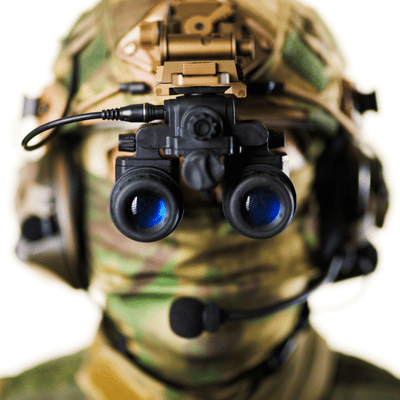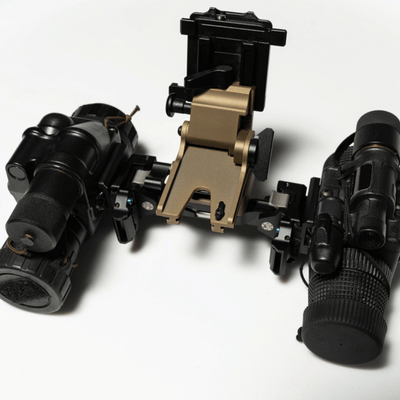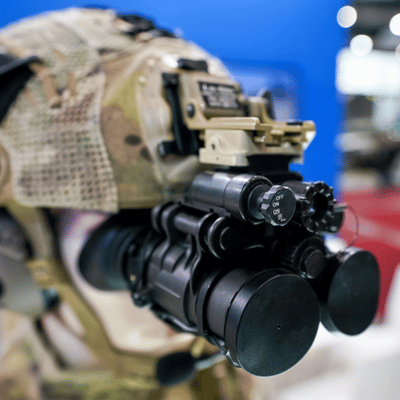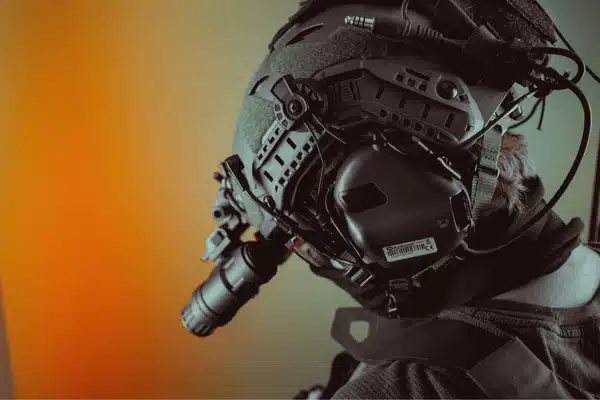Generation 3 night vision goggles give pilots a major advantage in low light conditions. These military grade tools turn starlight into clear images using advanced image intensifier technology, which is a big step up from earlier generations. Like all precision equipment, even this kind of technology has a service life.
That is why most pilots and operators ask the same question. How long will these goggles actually work compared with older generations, and when will the technology start to fade in performance?
Understanding Gen 3 Night Vision Technology and Lifespan

Gen 3 NVGs work by converting ambient light into electrons through a photocathode. These electrons multiply through a microchannel plate before hitting a phosphor screen. The result is that green glow pilots rely on for night ops.
What sets Generation 3 apart from earlier generations is the gallium arsenide photocathode. This material grabs more light and creates sharper quality images than older technology. Generation 3 devices also pack autogated power supplies that protect the image intensifier tube from sudden bright flashes.
The performance boost over older technology is huge. Generation 1 tubes might give you 1,500 hours of use. Generation 2 pushes that to about 5,000 hours. Generation 3 tubes hit 10,000 hours or more under normal usage. High quality units can reach 12,000 to 15,000 hours with proper care.
Think about that math. One hour per night gets you 27 years before hitting 10,000 hours. That’s a career’s worth of night flights.
But here’s the key point. That 10,000 hour mark doesn’t mean your goggles die. It means you might start seeing performance degradation. The tubes typically show gradual decline rather than sudden failure.
Many users report tubes actually improve in the first 500 hours as they burn in. After that, any performance drop happens slowly over many years.
Even past rated life expectancy, Generation 3 devices often keep working. The image might get dimmer, show more sparkle, or develop small blemishes. But the goggle still functions. Premium manufacturers like ITT and Elbit Systems rate their Pinnacle tubes for 10,000 hours with exceptional reliability.
Many high end aviation NVG technology come with 5 or 10 year warranty protection. That tells you something about expected durability. Generation 3 technology represents a serious investment that pays off through years of reliable service.
Factors Affecting NVG Longevity and Performance
Several factors determine actual tube life and image quality over time.
Usage Frequency Matters Most
Heavy usage means more operating hours. Pilots flying long night missions will burn through that lifespan faster than weekend operators. Track your usage in a logbook to know where you stand. Usage frequency directly affects how quickly you reach that 10,000 hour threshold.
The tubes are built for normal usage, so don’t worry about regular operations. Just understand the intensifier is a consumable component that wears gradually with each hour.
Bright Light Causes Photocathode Wear
Every image intensifier tube can only process so much light before the photocathode breaks down. Direct exposure to flares, searchlights, or daylight without protection accelerates this photocathode wear significantly.
Generation 3 goggles have auto gating to protect against sudden brightness. These circuits cut gain instantly when light spikes. But they don’t make tubes invincible. Intense or long light exposure still ages the components.
Always use objective lens caps during daylight testing. Never point active goggles at bright sources. This simple protection extends longevity significantly.
Environmental Conditions Take a Toll
Harsh environments shorten life span fast. Temperature extremes warp plastic parts or affect power supplies. Quick temperature shifts cause internal fogging in sensitive components.
High heat damages housings and seals. Extreme cold messes with batteries and electrical systems. Moisture leads to corrosion and fungus on optics. Dust and sand scratch lenses or get inside housings.
Desert operations, marine environments, and humid conditions demand extra care and protection. Store and transport goggles in sealed cases with desiccant packs to maintain proper storage conditions.
Physical Impacts Break Things
Generation 3 NVGs are tough but still precision optical instruments. Drops and impacts misalign optics or crack the delicate microchannel plate. That glass plate contains millions of tiny channels. One hard shock can cause fractures or ruin the tube entirely.
Modern unfilmed tubes handle shock better than older filmed versions. But treat every NVG with respect. Use padded cases, secure helmet mounts, and handle gently. Physical damage is a top cause of malfunctions and equipment failure.
Maintenance Practices Make or Break Longevity
Good maintenance adds years to your NVG. Poor maintenance destroys expensive gear. Dirty optics cause scratches and poor image quality. Loose screws let moisture in. Ignored problems become big malfunctions.
The next section covers specific maintenance practices in detail. For now, know this: how you care for your goggles directly affects their working life and overall longevity.
Maintenance and Care Tips to Maximize NVG Lifespan
Proper care and upkeep dramatically extends Generation 3 NVG performance and reliability.
Inspect Every 180 Days

FAA guidance recommends detailed inspection twice yearly. Certified technicians check tube performance, alignment, calibration, and any damage during these servicing appointments.
Before each flight, do a quick pre use check yourself. Verify fresh batteries, no visible damage, and all controls work properly. Regular checks catch small issues before they cause failures.
Clean the Right Way
Clean optics prevent both poor quality views and long term damage. After use in dirty conditions, remove dust with a soft brush or air blower. Use lint free lens paper and proper cleaning solution for smudges.
Never use harsh chemicals that strip protective coatings. Keep battery contacts free of corrosion. Remove leaked batteries immediately. Regular cleaning maintains like new performance for years.
Store in Controlled Conditions
Always store goggles in their protective case when not flying. The case should be padded and kept in cool, dry, dark locations. Avoid hot cars, freezing garages, and humid basements.
Place caps on the device before storage to prevent accidental light exposure. Add silica gel packs to absorb moisture. Remove batteries if storing more than a few days to prevent leaks. Good storage protects against environmental stress and extends battery life.
Handle With Care
Use helmet mounts and lanyards to prevent drops. Power off before handing to others. Don’t press on lenses or yank battery packs. Transport in padded cases only. Proper handling prevents damage to delicate components.
When moving between temperature zones, let the device acclimate inside its case. This prevents condensation and potential malfunctions. Treat NVGs like expensive cameras and they’ll last. Good handling practices are essential maintenance steps.
Get Professional Servicing
Send goggles to certified repair stations for scheduled maintenance. Military and civilian units typically follow 180 day or annual schedules. Technicians realign optics, check specs, and replace worn parts.
Never attempt home repairs beyond basic care. Opening housings voids warranty coverage and risks damage. High voltage components inside make DIY work dangerous. Leave technical work to qualified pros.
Manage Batteries Properly
Use specified battery types only. Most aviation NVGs run on AA alkaline or lithium cells. Don’t store units with batteries installed long term. They leak and destroy electronics.
Replace in pairs when one runs low. Keep spares handy and swap proactively. Clean contacts as needed to maintain reliable connections.
These maintenance practices significantly boost longevity and performance. Like any high tech gear, consistent wear and tear happens with use. But diligent care keeps that wear slow and manageable. Comprehensive checks every 180 days plus daily care preserve quality for years.
Recognizing Degradation and When to Repair or Replace
⚠️ Warning Signs Your NVGs Need Attention
Recognize these degradation symptoms early to prevent equipment failure and maintain flight safety
Dimmer Images
If you constantly need more gain to see the same detail, your photocathode sensitivity has dropped. This normal aging happens after thousands of operating hours and signals performance degradation.
Moderate ConcernIncreased Noise
More sparkle or scintillation in dark areas means your signal to noise ratio is declining. The tube isn’t amplifying as cleanly as when new, creating that grainy appearance.
Moderate ConcernNew or Growing Blemishes
Small dark spots are normal from manufacturing. But new spots or growing marks suggest phosphor wear or microchannel plate burn in from light exposure. Watch for changes in image quality.
High ConcernFlickering or Cutting Out
When tubes flicker or cut out intermittently, something’s seriously wrong. Could be loose wiring, power supply failure, or dying tubes. This needs immediate attention to avoid mid flight failure.
Critical IssuePersistent Blurriness
If focusing doesn’t help and cleaning changes nothing, tube resolution may be degrading. Could also mean optical misalignment from impact. Both need professional diagnosis immediately.
High ConcernHigh Operating Hours
Past 12,000 to 15,000 hours, start planning for replacement even if performance seems okay. You’re well past peak capability and closer to potential malfunctions or complete failure.
High ConcernEven with perfect care, tubes eventually show age. Know these warning signs so you can act fast and avoid costly malfunctions.
Dimmer Images: If you need more gain to see the same detail, photocathode sensitivity has dropped. This normal aging happens over thousands of hours and signals performance degradation.
More Noise: Increased sparkle or scintillation in dark areas means declining signal to noise ratio. The tube isn’t amplifying as cleanly as when new.
New Blemishes: Small dark spots are normal from manufacturing. But new spots or growing marks suggest phosphor wear or microchannel plate burn in from light exposure. Watch for changes in image quality.
Flickering Pictures: When tubes flicker or cut out, something’s wrong. Could be loose wiring, power supply failure, or dying tubes. This needs immediate attention to avoid mid flight failure.
Blurry Views: If focusing doesn’t help and cleaning changes nothing, tube resolution may be degrading. Could also mean optical misalignment from impact. Both need professional diagnosis to determine cost considerations.
High Hours: Past 12,000 to 15,000 hours, start planning for replacement even if performance seems okay. You’re well past peak capability and closer to potential malfunctions.
Don’t ignore these signs. Flying with degraded NVGs is unsafe. You rely on clear vision for critical night operations in challenging environments. Take action when you spot problems.
First, check thoroughly to rule out simple fixes. Then contact qualified NVG providers. Often, replacing just the image intensifier tube restores like new quality without buying new goggles.
Tube replacement protects your initial investment in housings and accessories. Some operators upgrade to newer ultra high spec tubes during replacement for better performance and extended life expectancy. Always use authorized service centers for tube work. They’ll purge, align, and test properly while maintaining your warranty.
Gen 3 NVGs: Built to Last With Proper Care

Generation 3 night vision goggles deliver 10,000 hours or more of reliable service. That’s decades of flying for most pilots. The technology uses military standards for durability and reliability. Tubes rarely fail suddenly. Instead, they gradually lose performance over many years.
Understanding what affects operating life helps you protect your gear. Usage patterns, bright light exposure, harsh conditions, physical handling, and maintenance all play major roles. Control these factors and your goggles stay sharp longer.
Follow recommended care guidelines. Check regularly, clean properly, store correctly, handle gently, and get professional checks on schedule. These habits preserve quality and extend tube life significantly.
Your NVGs represent a significant investment in flight safety. They turn pitch black nights into navigable terrain. When maintained right, they provide clear, bright images whenever you need them in any conditions.
Don’t wait until your goggles fail in flight. Start a maintenance logbook today. Track your hours and schedule your next 180 day check. Your safety depends on equipment you can trust in the darkest environments.
Frequently Asked Questions
How many hours do Gen 3 night vision goggles typically last?
Generation 3 tubes usually deliver 10,000 hours under normal conditions. High quality tubes can reach 12,000 to 15,000 hours with good care and maintenance.
What causes night vision tubes to wear out faster?
Bright light exposure causes the most damage to tubes and accelerates degradation. Poor storage, rough handling, and neglected maintenance also speed up wear significantly.
Can I replace just the tube when my NVG degrades?
Yes, tubes can be replaced individually by certified technicians without voiding warranty. This restores performance without buying a complete new system and protects your investment.
How do I know when my night vision goggles need servicing?
Watch for dimmer images, increased noise, new blemishes, flickering, or blur that won’t focus. Professional checks every 180 days catch issues early and maintain life expectancy.

